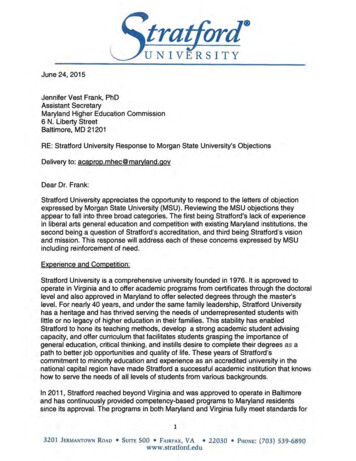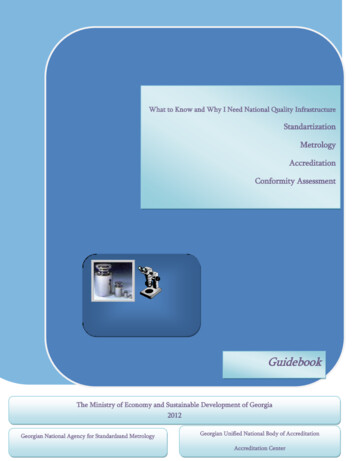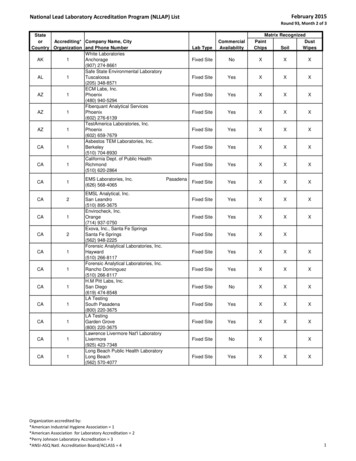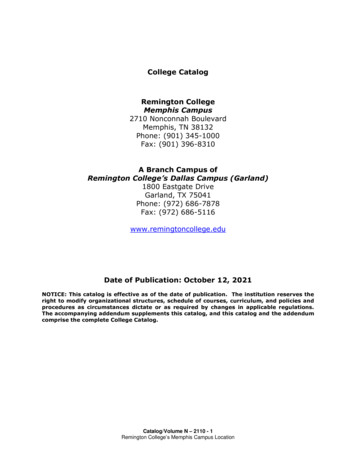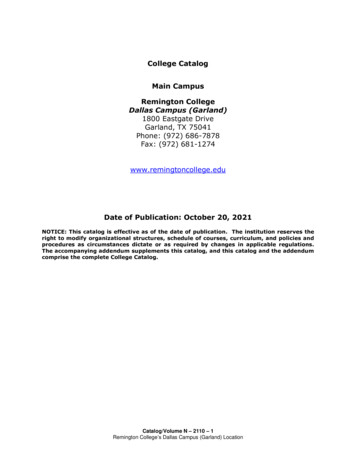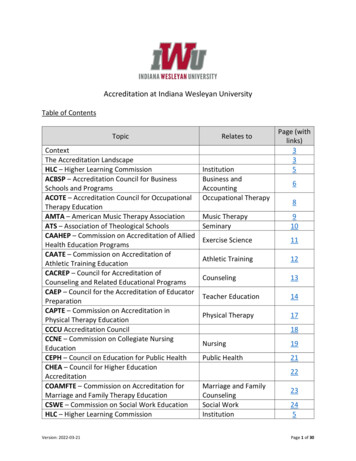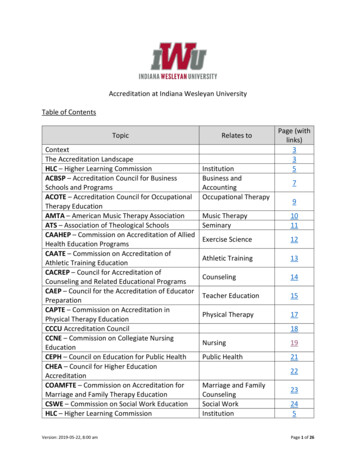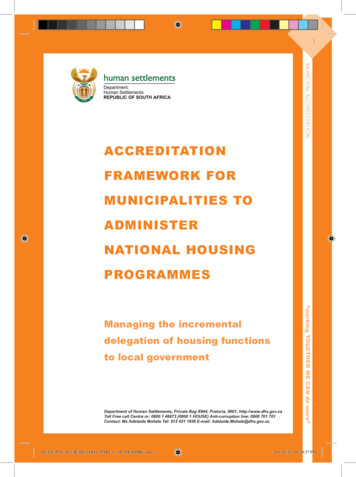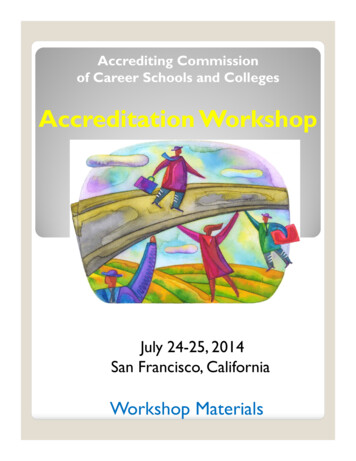
Transcription
Accrediting Commissionof Career Schools and CollegesAccreditation WorkshopJuly 24-25, 2014San Francisco, CaliforniaWorkshop Materials
Agenda - Renewal of AccreditationAccreditation WorkshopJuly 24-25, 2014San Francisco, CaliforniaThursday, July 24, 20148:30 am – 9:30 amRegistration for RenewalsPlease stop by the registration desk to sign in for the Accreditation Workshop, receive your name badge, copyof the Standards of Accreditation, as well as all other information required for the accreditation workshop.Please note that breakfast is on-your-own.9:30 am – 11:00 amSession A: 11:00 am – 11:15 amReview Workshop ObjectivesState of the CommissionSmall Group Work: Strengths and ChallengesBreakSession B:11:15 am – 1:00 pmWelcome and Update from the CommissionThe Standards of Accreditation: A Blueprint for SuccessACCSC’s Standards of Accreditation describes the accreditation process and sets forth the base of essentialsagainst which a school studies and evaluates itself. This session will cover the following: A Holistic Approach to Quality Assurance Small Group Work: Key Sections to the Standards of Accreditation Questions and Answers1:00 pm – 2:30 pmLunchPlease note that lunch is included for all registered workshop attendees.
Thursday, July 24, 2014 (Continued)2:30 pm – 4:30 pmBreak TBD4:30 p.m. - 6:00 p.m.Session C: The Application Process Overview of the Application for Renewal of AccreditationSelf-Evaluation Report: Best PracticesThe Student Achievement StandardIndependent Third-Party Verification of Employment DataNetworking ReceptionParticipants are invited join the ACCSC-staff and workshop participants for a Networking Reception.
Friday, July 25, 20147:30 a.m. - 8:45 a.m.BreakfastPlease note that breakfast is included for all registered workshop attendees.8:45a.m. - 10:30 a.m.Session D: The On-Site Evaluation 10:30 a.m. - 10:45a.m.On-Site Evaluation ActivitiesTeam Summary Report (TSR)BreakSession E: Response and Commission Actions10:45 am – 12:00 p.m. 12:00 pmWorkshop ConcludesHow to Prepare an Effective Response for Commission ConsiderationPossible Actions Taken by the Accrediting CommissionParting Thoughts
July 24 -25, 2014Accreditation WorkshopSan Francisco, California
ACCSC Workshop TeamMichale McComisExecutive DirectorChristopher LambertAssociate Executive DirectorMichelle RagnettiConference and Events Coordinator
Overview of the Renewal of AccreditationWorkshop
Overview of the Renewal of AccreditationProcessOnsite Evaluation Date, TSR, and Commission Action are Tentative Dates
Workshop ObjectivesThe Accreditation Workshop is designed to providean opportunity for participants to develop an understanding of: The ACCSC organization, its mission, values, and strategicinitiatives; The Standards of Accreditation as a set of best practices; The principle steps of the ACCSC accreditation process,including on-site evaluation activities; The possible outcomes of a school’saccreditation (Commission Actions).applicationfor
Workshop ObjectivesDuring the Accreditation Workshop, participantswill have an opportunity to: To engage in a conversation about the evolving roleof accreditation Identify Strength and Challenges in the careercollege sector Actively participate in group discussion regardingbest practices in career education
Mission, Vision, Core Values& Strategic Pillars
Mission and VisionACCSC’s mission is to serve as a reliable authority oneducational quality and to promote enhanced opportunitiesfor students by establishing, sustaining, and enforcing validstandards and practices which contribute to the developmentof a highly trained and competitive workforce through qualitycareer oriented education.ACCSC’s vision of accreditation is one that assesses andenhances educational quality, fosters innovation and creativity,and provides opportunities for collaboration and cooperationwith accredited member institutions.
Core ValuesAs a way for the Commission to continually meet its mission in a committedfashion, ACCSC has established a values-based framework supported by thefollowing foundational core values:IntegrityAccomplishing our mission with a commitment to ethics, honesty, trust,consistency, and fairness.AccountabilityFulfilling our responsibilities to one another, the higher education community, andthe public.Continuous ImprovementCultivating personal and professional growth through learning, goal setting,innovation, commitment and participation.CommunityFostering a free and timely exchange of ideas and information in a collegialenvironment through the establishment of strong partnerships that emphasizerespect and mutual support.
Mission and AlignmentEnsure that ACCSC as an organization represents its memberinstitutions; recognizes challenges, trends and innovations; andcontinually meets its mission, vision, and values.ExcellenceEnsure that ACCSC’s Standards and Processes reflectbest practices in higher education and training andsupport self-evaluation, innovation, and continuousimprovement by its member institutions.StrategicPillarsMembership SupportPosition ACCSC as a driving force that supportsinstitutional and student success.LeadershipPosition ACCSC as a leading resource on accreditation,accountability, education assessment, and oversight.
State of the Commission
Enrollment as of June 30, 2013300,000290,000291,799280,000270,000 28% Decrease since 000190,000201020112012Based on 758 Annual Reports240,000Based on 778 Annual ReportsBased on 775 Annual Reports250,000
Institution Size By Student Enrollment - All Schools601‐900 Students6%901 Students4%301‐600 Students21%300 or Less Students69%Average Enrollment 303 Students300 or Less Students301‐600 Students601‐900 Students901 Students
Distribution of Programs by Program Area0200400600Allied Health507Automotive/Motorcycle/Marine510Business & Business Related367Information Technology369Beauty & Skin Care314Holistic Arts & Sciences285Art-Commercial & Industrial134Culinary Arts168Legal & Security234Electronics102Nursing & Health Aide201Architecture, Engineering, & Drafting75Aviation79Fashion & Interior Design38Radio, Television, Motion Pictures84Heavy Equipment Operator & Truck Driver87Specialized Fields79Art-FineOther Program Areas10001200140016001696Building & Industrial TradesVeterinary Science & Animal Related Arts80041163
Distribution of Programs By CredentialBaccalaureate Degree6%Master's Degree0.9%Associate Degree24%Certificate / Diploma69%Total Percentage ofDegree Programs 31%Certificate / DiplomaAssociate DegreeBaccalaureate DegreeMaster's Degree
Distribution of Degree Programs By Credential331Associate of Occupational Studies (AOS, OAD, SAD)393Associate of Applied Science304Associate of Science143Associate of Specialized Technology87Associate of Applied or Specialized Business1,287 Associate Degrees29Associate of Arts282Bachelor of Science (BS, BSN, BHS)30Bachelor of Arts25Bachelor of Fine Arts (BFA, BGA)351 Baccalaureate Degrees13Bachelor of Applied ScienceBachelor of Professional Studies1Master of Public Health1Based on 1,688 Total ReportedDegree Programs34Master of Science6Master of Business Administration50 Master's Degrees3Master of Fine Arts6Master of Arts050100150200250300350400450
Distribution of Student Enrollment By Program Credential150,650Non-DegreeAssociate of Occupational Studies (AOS, OAD, SAD)15,415Associate of Applied Science14,76012,072Associate of Science9082,959Associate of Applied or Specialized Business21,503Bachelor of Science (BS, BSN, BHS)Bachelor of Fine Arts (BFA, BGA)1,924Bachelor of Arts1,165Bachelor of Applied Science665Bachelor of Professional Studies0Master of Public Health2Master of ScienceMaster of Business Administration22% - Associate Degrees5,251Associate of Specialized TechnologyAssociate of Arts66% - Non-DegreePrograms11% - Baccalaureate DegreesBased on 5,389 TotalReported Programs229,953 Students2,02841Master of Fine Arts183Master of Arts4091% - Master's Degrees
Accreditation as Peer Review
Gatekeepers of Educational Quality:A Shared ResponsibilityState - Student (Consumer)ProtectionAccreditors - Academic Standardsand Quality of Student EducationalExperienceFederal Government Responsibilities as Fiduciaries ofFederal Student Aid Programs Clarify and articulate common understandings about the responsibilities ofeach member of the triad. Coordinate and increase communication among actors to achieve greatercommonality across the quality assurance/eligibility enterprise Practical Impact on Teach-Outs
Accreditation is Peer ReviewACCSC believes there is value in sustaining the determination ofquality as a non-government function.ACCSC believes that on matters of academic quality assessment,federal intervention into the relationship between accreditors andinstitutions should be minimal.
Strategic Initiatives
Strategic InitiativesExamine Standards and Processes in Key Areas Admissions Documentation Prior to Enrollment Bylaws Revisions Additional School Appointment Flexibility in Board Composition Removal of Term Private Increase in Number Public Institutions Seeking Accreditation fromACCSC Student Achievement Accountability - Revised Student Achievement Rates as of 7.1.14 Independent 3rd Party Verification
Strategic Initiatives – Enhance MemberServices Blueprints for Success - 2014 First Module: Preparing a Response for CommissionConsideration Second Module: Organizing an Effective Electronic Submission ReIssue of Monograph Series – July / August 2014 Learning Resource Systems Program Advisory Committees Institutional Assessment and Improvement Planning Self Evaluation: Best Practice Faculty Improvement Planning
Strategic Initiatives – Enhance MemberService Free Regional Workshops – 2015 Key Areas for Sustained Institutional Performance Launch of ACCSC Online Training Portal – September 2014 Website Upgrades New Student Letter Graduate Letter PDC ACCSC School Centered Approach to Compliance & Performance Practical Experiences from the Field from School Operators Best Practices in Career Education Hear from Experts from Across Higher Education
Strategic Initiatives Ensure Rigorous Standards /Assessment Focus Accountability is a Fundamental Tenet of Accreditation Ensure Proper Processes Consistency and Fairness in the Accreditation Process Diversity of Institutions Scalability Transparency Initiative What information and actions should ACCSC makepublic?
Strengths and Challenges
Strengths and ChallengesIn small groups, identify significant strengthsand potential challenges for the career collegesector/ACCSC accredited institutions. 3 Strengths 3 Challenges
July 24 -25, 2014Accreditation WorkshopSan Francisco, California
The Standards of AccreditationSession B
The Standards of AccreditationThe Commission has republished the Standards of Accreditation which is nowdated July 1, 2014 and replaces the April 15, 2012 version.The July 1, 2014 Standards of Accreditation also include additional guidance orrevisions in the following areas:Rules of Process and Procedure, Standards of Accreditation September 27, 2013 Call for Comment Distance Education Facility Commission Actions Substantive Change Rules Voluntary Closure NotificationSubstantive Standards, Standards of Accreditation September 27, 2013 Call for Comment Distance Education Facility Student Achievement Rates – Appendix VI Section IV (C)((3) – Disclosures (from the March 18, 2014 Accreditation Alert) Guidelines for Employment Classification VII Faculty Grandfathering – Formerly Appendix IV Instructions for Arbitration
The Standards of Accreditation Describes the accreditation process (Rules of Process and Procedure) Sets forth the base of essentials (i.e., standards of best practices)against which an institutions evaluates itself Each institution determines its own educational objectives(appropriate for postsecondary education) Each institution is evaluated based on how well it accomplishes itsannounced objectives, in accordance with the Standards ofAccreditation
The Standards of Accreditation The Standards of Accreditation ensure that each institution properlyprepares students for employment in their chosen field ACCSC emphasizes educational quality by focusing on outcomes: Student Graduation Rates Rates of Graduate Employment ACCSC also seeks to gain an understanding of the level of employersatisfaction, student satisfaction, and student success over time. Additionally, ACCSC assesses the effectiveness of an institution’seducational programs by evaluating the infrastructure that supportsthe delivery of programs
Goals of the Accreditation Process Ensure consistency in institutional operations Systematic application of institutional process and procedures All students have a comparable education experience All student have comparable access to services Promote self-evaluation and institutional improvement Accreditation is not about getting ready for an onsite evaluation It is about ensuring that an institution has the necessary resources andappropriate infrastructure to meet its stated mission and fulfill obligationsto students. Provide for public accountability Ongoing conversations regarding the availability and types of information forpublic consumption Growing movement that accreditation does not provide the information thatthe public needs to make an informed decision.
Accreditation: A Student Centered Approachto Quality Assurance
July 1, 2012 – June 30, 2013:260 Commission Actions: Renewal of Accreditation
129 Total Team Findings in 58 Team Summary ReportsConsidered at the May 2013 Commission Meeting
171 Total Team Findings in 60 Team Summary ReportsConsidered at the February 2013 Commission Meeting
July 1, 2012 – June 30, 2013:ACCSC Accredited Institutions on Reporting
Independent Third-PartyVerification of Employment Data
In 2011 ACCSC began engaging an independent third-partyto verify the employment data submitted by schools selectedas part of the annual random sample of the Annual Reports,which has been a successful monitoring mechanism. 4,000 Records in 2011 2,800 Records in 2012The purpose of the requirement isa) to assess the school’s compliance with Section VII (B)(1)(b),Substantive Standards, Standards of Accreditation and whether theschool has “verifiable” records of employment andb) to ensure that the institution’s records can be relied upon inmaking decisions about a school’s compliance with theCommission’s student achievement standards and benchmarks.
The Commission has always required itsaccredited member schools to submit verifiablerecords of initial employment. A high level of reliance is placed upon information, data, andstatements provided to the Commission by a school. Moreover, the Commission’s deliberations and decisions are madeon the basis of the written record of an accreditation review. A school must supply the Commission with completedocumentation of the school’s compliance with all accreditingstandards if it is to be granted and to maintain accreditation. ACCSC will provide an additional overview of this processduring Session C.
Student AchievementRevised July 1, 2014
Student Achievement RatesBased on data collected in the 2011-2013 Annual Reports submitted by ACCSC-accreditedinstitutions, the Commission has calculated new Student Achievement Benchmark Rates.The Commission is pleased to report that the rates of graduation and employment haveincreased in several categories indicating that schools are consistently performing better inrelation to the percentage of students graduated and the percentage of graduates employed.Graduation rate benchmarks appear to have increased due toa) better performance by schools in graduating students;b) calculating the graduation benchmarks using the total number of students available forgraduation and not the total number of students started, which is a truer reflection ofschool performance; andc) a compression of program length categories for longer programsThe new student achievement rates will be in effect for all Graduation and EmploymentCharts using a July 2014 Report Date and later.
Student Achievement RatesIn the short term (e.g., Graduation and Employment Charts using a July 2014Report Date), the Commission will take these increases into account whenreviewing a school’s reported rates and will assess a school’s performance relativeto the both the new benchmark as well as the previous benchmark.In the longer term, the Commission is working to refine protocols intended to giveboth schools and the Commission a framework for the review and assessment ofstudent achievement rates and to provide a framework for assessing rates that areabove benchmarks and above average as well as below benchmark rates
ESTABLISHED BENCHMARK GRADUATION RATESProgram Length inMonthsAverage Rates of GraduationDemonstrates Acceptable hmarkGraduationRates* /-1-392%8%84%-4-684%11%73% 47-972%12%60% 510-1269%14%55% 113-1565%14%51% 616-1862%15%47% 519-2360%18%42% 624 55%19%36% 3
ESTABLISHED BENCHMARK EMPLOYMENT RATEAll ProgramsAverage Rate of EmploymentDemonstrates Acceptable enchmarkEmploymentRate* /-8%68% 2
The Student Achievement Standard Schools must demonstrate successful student achievement by reportingacceptable rates of student graduation and graduate employment Required Graduation and Employment Rates are based on data provided byACCSC accredited institutions in the Annual Report A school whose graduation or employment rates falls below the required ratesmay still demonstration successful achievement taking into account economicconditions, location, student population served, length of program, students whowithdraw from training but still obtain employment, state requirements, andother external or mitigating factors.
Program Viability and AssessmentThe Commission expects schools to conduct a realisticassessment of the viability of program offerings and the factorsimpacting student achievement.In all cases, the Commission expects that a school will takeappropriate and responsible action regarding any programoffering that is not meeting expectations. Some guidingquestions include: At what rate are students graduating? At what rate are graduates passing licensure exams? At what rate are graduates getting a job in a training relatedfield?
Program Viability and Assessment Are graduation and employment rates getting better?Getting worse? Are there any mitigating factors impacting the school’s abilityto demonstrate successful student achievement? Did the school examine the rates of student graduation inrelation to admissions standards? What changes has the school made with respect to theprogram curriculum or career service initiatives? What do the members of the school’s Program AdvisoryCommittee say about employment opportunities?
Group Exercise
How does this standard benefit students?As an accredited school, what is the most challengingaspect of meeting this standard?What strategies have you employed to overcome thischallenge?
Section IIProgram Requirements
Keys to Success: Ready AccessCurriculum and lesson plans for all program offerings Provides meaningful job related training opportunities Documentation of the integration of the LRS into the curriculum. Example Student WorkProgram Advisory Committee Meeting Minutes Review and Assessment of curriculum, equipment, student achievement, etc. 2 Per year / At Least 3 Employers or Practitioners from the fieldEquipment for each program offered by the school Does the school’s equipment reflect current occupational trends and practices? Properly Maintained / Safety Devices Sufficient in QuantityLearning Resource System Documentation of LRS Improvement Activities AccessibleCopies of the school’s externship plan Documentation of externship activities
How does this standard benefit students?As an accredited school, what is the most challengingaspect of meeting this standard?What strategies have you employed to overcome thischallenge?
Section II (A)(5), Substantive Standards,Standards of AccreditationProgram Advisory Committees (PACs)
How does this standard benefit students?As an accredited school, what is the most challengingaspect of meeting this standard?What strategies have you employed to overcome thischallenge?
Section IIIEducational Administration &Faculty Qualifications
Keys to SuccessSchool success is dependent on the quality of its faculty Professional Development Plans for ALL faculty Documentation of ActivitiesSchools must retain a strong and experienced faculty that iscontinually attentive to the needs of the students Prior Work Experience / Education Verification Personnel File Review Retention Data on Faculty Survey of StudentsFaculty are sufficient in number for the instructionalprograms offered by the school. Classroom Observations
How does this standard benefit students?As an accredited school, what is the mostchallenging aspect of meeting this standard?What strategies have you employed to overcomethis challenge?
Section IVStudent Recruitment
Keys to SuccessRecruitment in relation to student successEthical practices / Accurate portrayals Copies of All Advertisements Copies of Signed Codes of Conduct for RecruitersPermit prospective students to make informedand considered enrollment decisions withoutundue pressure Catalog and Enrollment Agreement
How does this standard benefit students?As an accredited school, what is the mostchallenging aspect of meeting this standard?What strategies have you employed to overcomethis challenge?
Section VAdmission Policies and Practices
How does this standard benefit students?As an accredited school, what is the mostchallenging aspect of meeting this standard?What strategies have you employed to overcomethis challenge?
Keys to SuccessConsistency in Admissions Decisions Admission decisions are based upon consistently applied criteriaDocumentation that Every Student Enrolled met the school’s admissionscriteria prior to enrollmentStudent, Graduate, Withdrawal Files Ready Access Copies of HS / GED International HS: Translated and Verified as Equivalent Entrance Exam Results Completed Enrollment Agreement Signed by the Student / Accepted by the School Prior to Start of Class Denial of Admissions File Going Back Five Years
Example of the results from an on-siteevaluation team’s review of documentation tosupport the systematic application of aschool’s admissions policy:
Example School Policy:In order to enroll into the Medical Assistant program: All applicants must have earned a high school diploma;or a GED; All applicants must pass the entrance examination byscoring 15 or higher; All applicants must take a blood test; All applicants must sign an enrollment agreement.
Documentation:The on-site evaluation team will review currentstudent and graduate files to determine ifdocumentation exists which demonstrates that theschool is applying its admissions standard in asystematic fashion.The following is an example of the results from anevaluation of our fictitious school:
Based on a review of 10 current student filesDoe, J. XXX-XX-1234; Missing copy of GEDSmith, J. XXX-XX-2345; Missing copy of signed EnrollmentAgreementSmythe, J. XXX-XX-2345; Missing copy of high school diplomaJones, M. XXX-XX-2345; Missing copy of blood testPoppins, M. XXX-XX-2345; Missing copy of entrance examresults
Keys to SuccessIn this example, 50% (5 of 10) of current student files reviewed bythe on-site evaluation team did not include all required elementsoutlined in the school’s admissions policy.Accordingly, based on this example, the school has notdemonstrated compliance with Section V, Substantive Standards,Standards of Accreditation.Consistency in the Admissions Process as Supported byDocumentation Available in Student Files.
Section VIStudent Services
How does this standard benefit students?As an accredited school, what is the mostchallenging aspect of meeting this standard?What strategies have you employed to overcomethis challenge?
Keys to SuccessAdvising and Counseling Coordinated by individual with appropriate professional andeducational qualifications Documentation of advising sessionsStudent Records Must be securely maintained and protected May be electronicMaintain a transcript for all formerly enrolled students Official transcript must be made available to studentupon request and in accordance with school policies Must be maintained indefinitelyMaintain financial records related to financial aid,tuition, fee payments, and tuition refunds for a periodof 5 years.
Keys to SuccessGraduate Employment Assistance andRecords Available as claimed by the school Public notice includes a notice on graduation population base andtimeframe Maintain verifiable records of initial employment for 5 yearsStudent Complaints Compliant policy and procedures published in school catalog Must include ACCSC Student Complaint Procedure Must maintain complete record of all written student complaintsfor at least the last five years
Consistent Applicationof Student ServicesStudent EnrollsAdmissions, Completed Enrollment Agreement,Catalog (Policies)Documentation of StudentAdvisingAcademicWritten Notice that ContinuedPoor Academic Performance willresult in TerminationAttendance /ConductWritten Notice thatContinued Poor Attendancewill result in Termination.Termination as Per StatedPolicy (Catalog)TutoringDocumentation ofTutoring Sessions
Section VIIStudent Progress
Keys to SuccessStudent Attendance Good student attendance is evident The school publishes and enforces an attendance policy DocumentationLeave of Absence Policies May not exceed 180 days within any 12 month period Must have signed request by student on file School must apply its refund policy if the student does not returnfollowing a LOA Bona Fide LOAs
Keys to SuccessSatisfactory ProgressWritten policy for assessing satisfactory student progressrelated to grades and attendance Grading criteria to assess a student’s academic progress that isreported at regular intervals Students must achieve a 2.0 upon graduation Training must be completed within 1.5 times the normal durationof the program (or 1.5 the credit hours required for credit hourinstitutions)Define and publish a probation policy, the effect of courseincompletions, withdrawals, and course repetitions Systematic Application of Policies via Documentation in StudentFiles
The Standards of AccreditationSession B
The Application ProcessSession C
The Accreditation Process The accreditation process is the cornerstone of ACCSC’sability to continually ensure the high quality of educationin our accredited member institutions. The accreditation process provides an opportunity for an institution toconduct a comprehensive review of all academic and ancillary activitiesand resources that support an institution’s mission and educationalobjectives By applying for and receiving accreditation, an institution accepts theobligation to demonstrate continuous compliance with the Standards ofAccreditation While ACCSC employs its own fact-finding methods to determine aninstitution’s compliance with accrediting standards, the burden rests withthe institution to establish that it is meeting ACCSC’s standards
Deadlines for Schools Seeking Renewal ofAccreditationAttend Accreditation WorkshopJuly 24-25, 2014Submit two electronic copies of the Application forRenewal Accreditation, with all attachments ( 45 days):September 8, 2014Submit four electronic copies of revised Application forRenewal Accreditation, four electronic copies of the SelfEvaluation Report, and on-site evaluation fee ( 6months):January 21, 2015
The Application for Renewal Accreditation:Significant ChangesIndependent Third Party Verification of EmploymentThe school must engage an independent third-party to verify theemployment data in the G&E Chart(s) submitted in the most recentlysubmitted Annual Report at the time of the due date of the SER.Personnel Reports Faculty Personnel Reports are no longer required Matrix of Faculty (by program) with Responsibilities Organizational Chart of all StaffSubstantive Changes: Chronological List of all substantive changes during the last cycleof accreditation.Catalog Transfer of Credit Policy
Critical Resources: Website and WebinarsThe Application for Renewal of Accreditation andSelf Evaluation ReportAvailable for download at www.accsc.org, under the FormsSection.Webinar on Electronic SubmissionsThis webinar focuses specifically on preparing the Application forRenewal of Accreditation and includes a tutorial on creatingbookmarks, inserting pages, and embedding hyperlinks.Webinar on Preparing a Response for CommissionConsiderationThis webinar provides an overview of the keys to a successfulresponse, sample response models, and documentation strategies.All webinars are available under the Events Section atwww.accsc.org
DisclosuresHas any owner or manager been directly or indirectly employed or affiliatedwith any school which has lost or been denied accreditation by anyaccrediting agency during that individual’s period of employment or affiliation?Has any owner or manager been directly or indirectly employed or affiliatedwith any school which has closed or entered into bankruptcy during thatindividual’s period of employment or affiliation?Is any action pending (e.g. court action, audit, inquiry, review, administrativeaction), or has action been taken, by any court or administrative body (e.g.fede
Please stop by the registration desk to sign in for the Accreditation Workshop, receive your name badge, copy of the Standards of Accreditation, as well as all other information required for the accreditation workshop. Please note that breakfast is on-your-own. 9:30 am - 11:00 am Session A: Welcome and Update from the Commission

